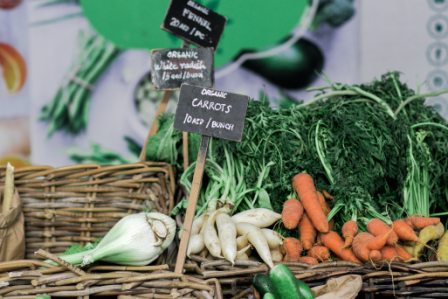
Once upon a time, organic food was available only at health food stores, marketed to “tree-hugging” consumers willing to pay extra for “natural,” environmentally friendly foods. Today, organic foods are undeniably mainstream. Not only can they be found at most every neighborhood grocery store, but even giants like Walmart are getting into the act. People who buy organic are seeking assurance that food production is gentle to the earth, and/or looking for safer, purer, more natural foods. But are organic foods really worth the added expense?
When I say “going organic,” I do not mean an all or nothing approach. As with all of my advice, I strive to focus on what will give the most “bang for the buck” in regards to convenience, cost, your comfort zone and health benefits. As with many nutritional subjects, there are far more questions and confusion than definitive answers. With most topics, I read about the prevailing research and mix in a heavy dose of common sense and voila, I find my direction. There is always a middle ground that makes the most sense to me.
Here are the compelling reasons to choose organic, even if it’s only a portion of your purchases. Organic produce often has higher levels of potentially healthy compounds. These are polyphenols, a strong antioxidant that combats many chronic diseases including cancer and Type 2 diabetes. Organics will also reduce your exposure to many toxic chemicals that have been shown to cause health issues. The impact is greater on developing children and developing fetuses, but we all can benefit from a lower dose of toxins. Many of these substances are neuro-toxins and carcinogens. Research has shown that high levels of these toxins resulted in lower IQ scores in children. Another issue is the environmental impact on the world. Reports paint a stark picture of diminishing populations of pollinators such as bees and butterflies, as well as the pollution of our waterways.
What does the term “organic” mean? Organic foods can include fruits, vegetables, grains, dairy foods, eggs and, to some extent, meats and poultry. Organic foods are defined as those foods that are grown without the use of synthetic fertilizers, sewage sludge (human and animal waste—yuck), irradiation, genetic engineering, pesticides or drugs. Pesticides are chemical or control agents made to kill insects, weeds and fungal pests that damage crops.
Over the past few years, there have been many studies that have stated there is no benefit to organic produce vs. conventional produce. The confusion is rooted in poor research. In order to make a good comparison, you need to study produce from the same environment. A poor study would compare conventional grapes grown in New York with organic grapes grown in Florida. A good piece of research would study the grapes grown side by side with the same soil, sunlight, etc.
Here are some thoughts and recommendations: Food does not have to be organic to be safe and environmentally friendly. One good strategy is focusing on eating food grown close to where you live. Some organic foods come from multinational companies and have been trucked across the country. They may be organic, but the environmental footprint includes lots of petrochemicals used in transportation, whereas if you buy produce from your local market, it may not be organic but it is farm-fresh and less impactful on the environment. Some smaller farms may not have the organic label—which can be costly to obtain—but follow similar practices.
Buying local allows you to talk to the farmers and get to know their practices.
And just because food is labeled organic doesn’t mean it is completely free of pesticides. Contamination can occur from soil and ground water containing previously used chemicals, or during transport, processing and storage.
I advise those on limited budgets to consider buying organic versions of foods on the Environmental Working Group’s “Dirty Dozen” list, or focus on organic versions of foods eaten most frequently. Eating more fruits, vegetables and whole grains and less processed foods remains the goal.
EWG’s Dirty Dozen for 2014 (see www.ewg.org) list of produce contained a number of different pesticide residues and showed high concentrations of pesticides relative to other produce items.
EWG’s Clean Fifteen for 2014 includes the produce least likely to hold pesticide residues, and tests found low total concentrations of pesticides. Don’t waste your money buying organic here, go for the conventional to save a little.
One thing the experts agree on — regardless of whether you choose locally grown, organic, or conventional foods, the important thing is to eat plenty of fruits and vegetables. The health benefits of such a diet far outweigh any potential risks from pesticide exposure. Given what we know, the best diet advice I can give is to eat a wide variety of produce and whole grains. What do I do? I buy organic as long as it fits into my budget and does not break my piggy bank.
When to Go Organic
Dirty Dozen
The Environmental Working Group’s “Dirty Dozen” list includes produce with the highest levels of pesticide residues. Focus on organic versions of these foods or the foods eaten most frequently.
Apples, strawberries, grapes, celery, peaches, spinach, sweet bell peppers, imported nectarines, cucumbers, cherry tomatoes, imported snap peas and potatoes.
Clean Fifteen
EWG’s Clean Fifteen for includes the produce least likely to hold pesticide residues. Relatively few pesticides were detected on these foods, and tests found low total concentrations of pesticides. The list includes:
Avocados, sweet corn, pineapples, cabbage, frozen sweet peas, onions, asparagus, mangoes, papayas, kiwis, eggplant, grapefruit, cantaloupe, cauliflower and sweet potatoes.
Dr. Stuart Offer contributed this article.






Comment here